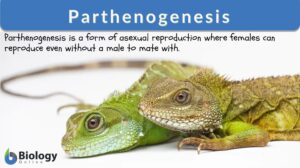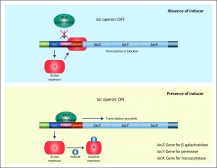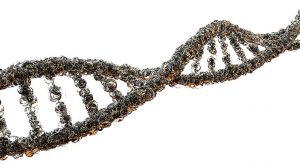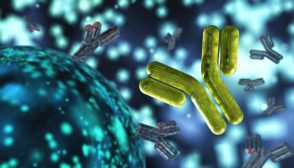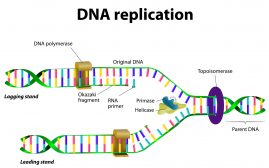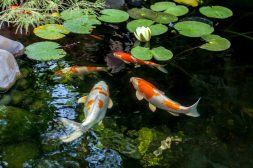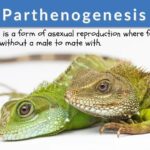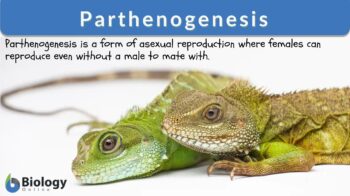
Parthenogenesis
n.
Definition: a type of asexual reproduction in which the female gamete develops into the offspring without being fertilized by a male gamete.
Photo credit: Skip Brown/Smithsonian’s National Zoo
Table of Contents
To reproduce, by definition, means to produce new offspring. The process is referred to as reproduction, which is one of the features of a living thing. It is a means to maintain a species. There are two types of reproduction: sexual and asexual reproduction. In biology, sexual reproduction is defined as a mode of reproduction wherein a gamete containing only one set of chromosomes (haploid) combines with the other gamete to form a diploid offspring. For example, animals sexually reproduce via a haploid egg cell (also called an ovum) and a haploid sperm cell to produce a diploid zygote. Sexual reproduction is the most common method of reproduction in multicellular eukaryotes, such as plants, fungi, and mammals. In contrast, organisms that reproduce asexually may not divide by meiosis to form gametes. Instead, they give their full genome to the offspring by a method similar to mitosis. This is seen in organisms that reproduce solely by asexual means.
Let’s talk about parthenogenesis. Join us and participate in our Forum: Asexual and sexual reproduction differences
Parthenogenesis Definition
What is parthenogenesis? Is parthenogenesis an asexual reproduction? Parthenogenesis is a form of asexual reproduction by self-impregnation resulting in the production of a zygote from an unfertilized egg. Thus, it is also referred to by many as “virgin birth”. Parthenogenesis takes place in both asexual animals and plants. In animals, the embryo develops from an unfertilized egg. In plants, it is a part of the process, apomixis. Parthenogenesis occurs in many types of invertebrates including scorpions, nematodes, mites, water fleas, wasps, some bees, and other insects. Parthenogenesis may occur in some vertebrate animals as well, such as amphibians, some fish, reptiles, and in few bird species.
Parthenogenesis has been observed in some types of sharks, such as the blacktip shark, the bonnethead shark, and the zebra shark. The zebra shark (Stegostoma fasciatum) can alternate between sexual and asexual reproduction by parthenogenesis. They go for asexual especially in the absence of a potential mate.

Several species of insects can reproduce asexually by parthenogenesis including honeybees and ants. Another example of a parthenogenetic invertebrate is the water fleas (daphnia of order Cladocera). The water fleas are not insects but small crustaceans. They reproduce through parthenogenesis with an adjunct sexual reproduction, mostly depending on the environmental conditions. They reproduce sexually by producing resting eggs that may survive harsh conditions. But in favorable conditions, they reproduce asexually, producing female clones. When the conditions become less favorable, they asexually reproduce male offspring to mate with the females, and so sexual reproduction can occur.
Biology definition:
Parthenogenesis is a form of asexual reproduction wherein the offspring develops from the egg or female gamete without the prior fertilization from the male gamete. Parthenogenesis is regarded as a form of asexual reproduction because a zygote develops without the union happening between female and male gametes. It is a common means of reproduction in plants, invertebrates (such as water fleas, aphids, stick insects, some ants, bees, and parasitic wasps), and certain vertebrates (such as some reptiles, amphibians, fish, and few birds).
Etymology: from Greek “Parthenos”, meaning “virgin” and “genesis’, meaning “birth”, “creation”, “origin”. Synonyms: parthenogeny, apomixia. Related forms: parthenogenetic (adj., definition: of, pertaining to, or produced by, parthenogenesis)
Types of Parthenogenesis
Parthenogenesis is commonly typified as either automixis parthenogenesis or apomixis parthenogenesis. In automixis parthenogenesis, the egg cell fuses with the polar body to produce an embryo. This merge can shift the genes of the mother to produce new alleles so the offspring is similar to the mother but not a full clone. The produced organism gets two X chromosomes from the mother. Therefore, automixis parthenogenesis produces female offspring only. Rarely, fertile males can be produced having only one X chromosome. These are fertile because their sperm cells contain the X chromosome only. In apomixis parthenogenesis, the egg cells do not undergo meiotic division so when an egg cell divides, it is a replicate of the original cell in terms of the genes present. Therefore, the offspring will be a full clone of the mother. This form is most commonly found in plants. This type of parthenogenesis produces identical offspring which are genetically similar to the parent.
Parthenogenesis may be facultative or obligate. Facultative parthenogenesis is one in which the female reproduce either sexually or asexually. Mayflies are capable of facultative parthenogenesis. They undergo parthenogenesis when viable males are absent from the habitat. Obligate parthenogenesis is one in which the organism reproduces only by asexual means. Certain species of reptiles (most of them are lizards) are capable of obligate parthenogenesis.
How Parthenogenesis happens
The egg cells are haploid cells produced from the ovaries by meiosis. A precursor cell after meiosis produces an ovum and three polar bodies (small byproducts of meiotic division). In sexual reproduction, the polar bodies eventually degenerate. That’s what happens in human egg cells following meiosis. But for other organisms, the ovum may fuse with the polar body such as in the case of automixis parthenogenesis (also called meiotic parthenogenesis) described in the previous section. The egg fuses with the second polar body. Thus, although there is no sperm cell involved in increasing gene diversity, this form of parthenogenesis offers a degree of genetic variation among offspring.
Typically, the egg cell after meiosis is haploid, meaning it contains half the number of chromosomes of the original cell. In parthenogenesis, the offspring may be diploid or haploid depending on the mechanism of parthenogenesis.
Based on the fate of the offspring, the condition may be described as follows:
- arrhenotokous, when an unfertilized egg develops parthenogenetically into a male
- thelytokous, when an unfertilized egg develops into a female
- deuterotokous, when an unfertilized egg is capable of developing into either a male or a female
Some insects can reproduce sexually and asexually. They tend to reproduce asexually (a case of facultative parthenogenesis or cyclic parthenogenesis) when the conditions are favorable as this allows a rapid increase in the number of offspring. In unfavorable conditions, they reproduce sexually, which is essential to produce a dormant egg that can live for a long time and hatch once the environmental conditions are favorable again. Sexual reproduction can be beneficial in terms of boosting genetic variation. Thus, it is advantageous to have the ability to sexually reproduce even if they already have the ability to reproduce asexually.
Some social insects reproduce sexually by gametes to produce workers and soldiers while queens are reproduced asexually, by parthenogenesis. Queens are produced by the closure of sperm gates in eggs to prevent sperm cells from entering. Other populations lack males so they never reproduce sexually but reproduce asexually by obligate parthenogenesis.
Benefits of Parthenogenesis as a Form of Reproduction
Parthenogenesis is a method of self-reproduction in which the egg cells develop into offspring in the absence of a mate. Thus, parthenogenetic animals and plants may still reproduce their own kind without the need to exert time and effort in looking for a suitable mate. The female can then use this time to search for food and shelter where these resources are available. For example, aphids reproduce asexually by parthenogenesis during summer since green leaves are available and the daytime is longer.
Asexual parthenogenesis enables a population to grow as twice faster as a population that reproduces sexually. Parthenogenesis enables rapid reproduction and increases in population size without the need for fertilization. Therefore, parthenogenesis is faster and easier than sexual reproduction since it does not depend on the presence of a male. In fact, females that reproduce by parthenogenesis can produce the same number of offspring as sexually reproduced females but with only half the size of the population saving more resources.
In parthenogenetic species, one individual is capable of forming a colony without mating, producing female offspring that may grow and reproduce again to provide a large number of offspring in a short period of time. Moreover, some parthenogens can maintain the ability to incorporate new genes during the cycle of sexual reproduction. Therefore, they can maintain their evolutionary process while producing a great number of offspring.
Sexual reproduction does have greater genetic diversity than parthenogenesis. However, parthenogenesis may prove beneficial in a way that it produces clones having the same genes for favorable traits as inherited from their parents. So, if the mother lives in a habitat to which she has adapted, her offspring will carry the same genes to ensure their survival in such an environment.
Parthenogenesis is now being tested on human eggs to stimulate the egg to develop without fertilization. This approach may help researchers to find a new method of producing human stem cells from an unfertilized egg or even to clone humans. See section: Parthenogenesis in humans
Disadvantages of Parthenogenesis as a Form of Reproduction
Parthenogenesis is a form of asexual reproduction. Thus, it is characterized by a lack of genetic diversity since the offspring gets all genetic material from one parent only. Lack of genetic diversity predisposes the offspring to the same diseases and same conditions as its parent. Moreover, negative mutations, as well as unfavorable traits, will persist in many generations. Furthermore, the offspring produced by parthenogenesis is a clone of the parent so it cannot adapt easily or survive when the condition changes and becomes unfavorable. That’s why parthenogenesis may produce a large number of organisms that cannot survive through any slight change in their environment.
Do you think parthenogenesis is generally beneficial or disadvantageous? We’d love to hear your thoughts! Join our Forum: Asexual and sexual reproduction differences
Examples of Parthenogenesis
Parthenogenesis takes place spontaneously in rotifers, daphnia, nematodes, aphids, as well as other invertebrates and plants. Among vertebrates, birds, snakes, sharks, and lizards are the only species that can reproduce by strict parthenogenesis. While other amphibians, fish, and reptiles can perform different forms of hybridogenesis, which is a form of incomplete parthenogenesis. Other species such as the blacktip and hammerhead sharks as well as the Komodo dragon usually reproduce sexually; however, these species may sometimes reproduce asexually by parthenogenesis. Parthenogenesis may be artificially induced in mammals to produce animal clones, i.e., the offspring is genetically identical to the mother. In this process, the egg cell is artificially stimulated to undergo mitosis in order to produce a new organism.
Parthenogenesis in reptiles
How do snakes reproduce? Many snake species reproduce sexually but there are other snake species that are capable of reproducing asexually. Apart from snakes, other reptiles that reproduce asexually are certain species of lizards. Both the snake and lizard asexual reproductions may be in the form of facultative or obligate parthenogenesis.
In facultative parthenogenesis, a sexually reproducing reptile becomes parthenogenetic when males are lacking in their population. In this case, their population consists of members that may or may not be a clone of the mother’s genome as they reproduce by mating as well when an opportunity presents.
In obligate parthenogenesis, such as rock lizard and certain groups of geckos, they reproduce by parthenogenesis alone. In these species, the female egg develops into a new offspring without the contribution of the male in fertilization. There are about 50 lizard species and only 1 snake species that reproduce by obligate parthenogenesis.
Parthenogenesis in reptiles may produce either full clones that carry all the mother’s genes or produce a half-clone that combines a haploid genome of the reptile egg. Full clones are produced due to a certain modification in the normal process of haploid egg production where the genome of a female’s germ cell is doubled in a process known as pre-meiotic genome doubling. In this process, two-division cycles of meiosis produce a diploid egg instead of a haploid egg where two similar sister chromosomes produced during premeiotic genome doubling are separated during meiosis I. Identical chromosomes pair instead of the two homologous chromosomes that pair in sexual reproduction. Then, two identical sister chromatids are separated during meiosis II. Full clones are found among obligate parthenotes, like Lacerta, as well as facultative parthenotes such as the Burmese python.
Other species produce half clones. These usually reproduce by facultative parthenogenesis. Terminal fusion takes place between an egg cell and a haploid polar body. The polar body is a byproduct of meiosis. The fusion between the egg and polar body produces a diploid nucleus that develops into a diploid offspring. This method is similar to the fusion of an egg and sperm in sexual reproduction since it forms a diploid nucleus from the fusion of two different cells. The resulting offspring is a homozygote and gets about half of its mother’s genetic variation. This type of parthenogenesis could produce either a female or a male. Since the meiosis process takes place normally in individuals produced by this type of parthenogenesis, these individuals can reproduce either sexually or asexually such as some species of snakes and Komodo dragons.
Several types of Lizards are parthenogenetic such as Caucasian rock lizard species of genus Lacerta. Lacerta is true parthenotes, therefore, their egg is not fertilized by a sperm. Another genus is the Teiid of whiptail lizards, which is the most known evolutionarily type of reptiles that reproduce by parthenogenesis.
Parthenogenesis in whiptails is different since two females share in reproduction; one is ovulating which performs the typical role of an ovulating female and the other engages in courting behavior which is usually present in males. There are five genera containing six gecko species that reproduce by parthenogenesis. This species reproduces by female-female engagement. However, they can produce male offspring, this is thought to result from hormonal inversion which is not related to genes. The produced males are normal from the anatomical view; however, they are sterile since they produce abnormal sperms.
The only species of snakes that undergo obligate parthenogenesis is the brahminy blind snake.
Species that reproduce by parthenogenesis can undergo evolution since a triploid species produced by parthenogenesis was artificially fertilized by a sperm in a laboratory. The produced tetraploid organism acquired new genes and consequently new characteristics.
Parthenogenesis in humans
Parthenogenesis is common in some vertebrates including the whiptail lizard where the offspring develops from an oocyte without being fertilized by a sperm. So, no paternal inheritance occurs and the offspring genome is completely inherited from the mother.
Can parthenogenesis occur in humans? Parthenogenesis in humans, as well as androgenetic events, may spontaneously occur in humans. However, they can only produce tumors such as ovarian teratoma. The production of a parthenogenesis human depends on several factors including activation of the oocyte, meiosis, and genetic imprinting.
Parthenogenesis is not naturally a common type of reproduction in mammals. However, artificial induction of parthenogenesis in mammals included stimulation of the mammalian oocyte; The oocyte was activated and developed into an embryo by parthenogenesis. However, the resulting embryo will not develop further due to a lack of paternal genes, which are responsible for the establishment of the normal placenta. On the other hand, creating a fully fertile animal by parthenogenesis is possible by the technology of genetic modification, which manipulates the genome of the produced animal from an activated oocyte.
Asexual reproduction in humans is not common. Therefore, the parthenogenetic activation of a human oocyte is facing legal and ethical issues. However, this method of reproduction has medical, scientific, and economic reasons. For example, parthenogenesis may be used in different fields. Human stem cells have been studied for their regulatory mechanisms which are responsible for the development of an embryo or cloning experiments in different researches using the oocyte. Therefore, clinical human parthenogenesis in humans may reproduce cells such as embryonic stem cells that can be used in the favor of many patients. It can be used in organ transplantation with minimal risk of organ rejection.
Human oocyte activation is a complex process that requires several stimuli at different phases of the cell division cycle. At metaphase II, the unfertilized oocyte will not develop without a stimulus. The stimulus may occur due to the fertilization by a spermatozoon or using an artificial agent. The artificial agent permits the transition to anaphase, sister chromatids segregation, and expels the second polar body. The artificial agent must mimic the action of the sperm to trigger the development of an embryo.
Oocyte parthenogenetic activation can be performed by different types of stimuli. These stimuli are divided into chemical and physical stimuli. Even though different methods provide oocyte stimulation, however, they have different degrees of embryonic development and activation rates which affect the degree of success.
The produced embryo is a pseudodiploid, which contains the two maternal sister chromatids chromosomes in the oocyte. Spontaneous diploidization occurs since the resulting embryo contains one copy of sister chromatids in order to develop into a homozygous embryo. Then, the activating agent induced the extrusion of the second polar body and transition from metaphase II without performing diploidization. Therefore, the resulting embryo from this stage is a haploid embryo. Activation of the human oocyte by parthenogenesis to treat infertility is now of great interest since it can be used to produce embryos in areas such as assisted reproduction technologies itself, somatic cell, and nuclear transfer experiments and for the derivation of clinical-grade pluripotent embryonic stem cells for regenerative medicine. Different methods have been employed to activate human and nonhuman female gametes with different degrees of embryonic development.
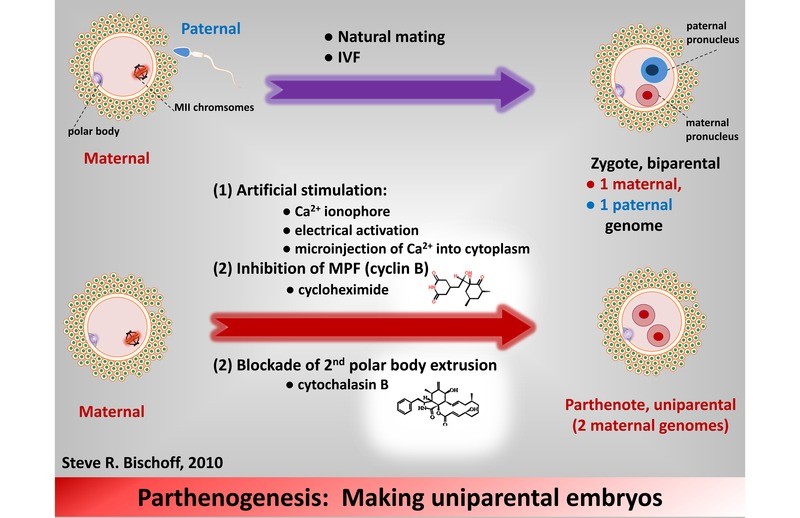
Parthenogenesis in birds
Parthenogenesis may occur naturally in some birds. However, surrounding conditions may affect the development of the unfertilized egg so it is usually abortive. Birds may reproduce by facultative parthenogenesis, producing diploid males only. The mechanism of parthenogenesis in birds is not clear yet, however, some researchers suggest that parthenogenesis may affect the normal fertilization as well as the natural development of an embryo. For example, turkey and virgin quail that reproduce by parthenogenesis have shown less reproductive performance after sexual mating. Environmental factors, as well as genetic selection such as exposure to virus vaccines, may initiate parthenogenesis in birds.
Parthenogenesis in avian species can be studied to get more information about parthenogenesis among vertebrates. This information is useful in understanding the pathogenesis of ovarian cancers that develop from mammalian oocytes by parthenogenesis. Avian species represent a great model for such studies due to their small size, the short interval of generations, and earlier sexual maturity in comparison with chickens and turkeys. On the other hand, parthenogenesis is abortive in most birds such as pigeons, quail, turkeys, and zebra finches. However, when they were exposed to genetic selection, researchers were able to hatch a small percentage of turkey’s unfertilized eggs.
In parthenogenesis, the meiotic early stage is similar to fertilized egg where the number of chromosomes is reduced. Consequently, to restore the diploid number of chromosomes, the haploid egg nucleus and the haploid second polar body are fused or by endomitosis. As a result, the produced parthenogen has the same diploid chromosome number.
Parthenogenesis in bees
Diploid fertilized eggs of honey bees usually develop to produce females, while haploid unfertilized eggs develop to produce males by haploid parthenogenesis. In the somatic parthenogenesis of the honeybee, the number of chromosomes is reduced by meiosis. Unlike apomictic parthenogenesis in which no meiosis takes place.
In the honeybee, males are produced by unfertilized haploid eggs that develop by parthenogenesis into haploid males. Unfertilized eggs may be produced either by the queen or by unmated workers that produce males by parthenogenesis. It is not usual that workers lay eggs, however, this may occur as a result of certain circumstances such as the death of the queen. Workers cannot reproduce due to the presence of pheromones produced by the queen. So, they produce drones (males) by parthenogenesis only. On the other hand, some species of honeybees can produce a diploid queen by parthenogenesis when the queen dies to replace her and save the colony from collapse.
Honeybee females are produced by diploid fertilized eggs; however, they may also be produced by a haploid egg that can restore the diploid number of chromosomes during meiosis II to produce a diploid female. In cape workers, a worker or a queen female may be produced by the fusion of two haploid pronuclei to produce a diploid female at the second division meiosis. Some colonies use this feature to parasitize other colonies by producing numerous female offspring. Several recombination steps take place between the centrosome and a locus to place two allele pairs on the four chromatids. Therefore, parthenogenesis that involves recombination by this method has a one of three chance to produce a homozygous offspring since any chromatid will be randomly chosen to carry its alternate allele.
A honeybee can produce haploid males by parthenogenesis and diploid females by fertilization to increase the number of drones and workers.
Let’s take a closer look at parthenogenesis in bees by watching the video below.
Parthenogenesis in plants
Parthenogenesis is not restricted to animals only. It may also occur naturally in plants, especially in lower plants such as algae, mosses, and about 10% of ferns as well as about 1% of higher flowering plants. Parthenogenesis in plants is usually found in the form of a combination between the autonomous endospore formation and the apomeiosis which refers to meiosis omission, together termed apomixis means clonal seed production.
In plants, the female meiosis produces a haploid megaspore, which develops into a gametophyte. The haploid female gametophyte alternates with a diploid sporophytic generation following fertilization with a male sperm (haploid). In lower primitive plants such as ferns and mosses, the egg develops into the archegonia which is a special region. Moreover, the female gametophyte is larger and free-living. Since haploid embryos are not viable, a mechanism that restores or keeps the diploid number of chromosomes usually takes place with parthenogenesis.
Different mechanisms are involved in plant parthenogenesis where they produce either a true or partial clone of the maternal genome. One mechanism is known as apospory, in which the ovule sporophytic cell directly develops into a gametophyte. Another mechanism is known as diplospory, in which the mother cell megaspore undergoes endoreplication before meiosis. Both mechanisms can produce full clones of the mother. Rarely, a haploid egg cell develops without restoring the diploid number of chromosomes, the offspring is haploid and usually infertile.
The development of plant embryos produced parthenogenetically depends on other factors such as nutrition. Since angiosperms participate in the nutrition of an embryo by endosperm, which is formed during the fertilization process. This process is not significant in animal parthenogenesis since embryo nutrition usually depends on the mother. In lower plants, the embryo usually develops by parthenogenesis from gametophytic cells instead of the egg cell.
Apogamy is a type of parthenogenesis in plants where the embryo develops spontaneously from a sporophytic cell, this process is termed somatic embryogenesis. Withdraws of this process include the lack of embryonic sac development, the lack of seed coat, and endosperm. Another uncommon type of parthenogenesis in plants is the development of an embryo from cells other than egg cells. Instead, the embryo develops from leaves, protoplasts, pollens, gametophytic cells, or other tissues of the plant. These parts develop due to exposure to external stimuli such as heat stress or hormones. Researchers suggest that such a process would be useful in plant breeding by parthenogenesis artificial induction in different parts of the plant.
Parthenogenesis is just one of the many forms of asexual reproduction. Want to know the other types? Join our Forum: Asexual and sexual reproduction differences
Try to answer the quiz below to check what you have learned so far about parthenogenesis.
References
- Bierzychudek, P. (1985). Patterns in plant parthenogenesis. Experientia, 41(10), 1255-1264.
- Bos-Mikich, A., Bressan, F. F., Ruggeri, R. R., Watanabe, Y., & Meirelles, F. V. (2016). Parthenogenesis and human assisted reproduction. Stem cells international, 2016.
de Carli, G. J., & Pereira, T. C. (2017). On human parthenogenesis. Medical Hypotheses, 106, 57-60. - Ferguson-Smith, A.C. (2001). Encyclopedia of Genetics || Uniparental Inheritance. , (), 2096–2099.
- Fujita, Matthew K.; Singhal, Sonal; Brunes, Tuliana O.; Maldonado, Jose A. (2020). Evolutionary Dynamics and Consequences of Parthenogenesis in Vertebrates. Annual Review of Ecology, Evolution, and Systematics, 51(1), annurev-ecolsys-011720-114900–.
- Johnson, Alan L. (2015). Sturkie’s Avian Physiology || Reproduction in the Female. , (), 635–665.
- Maslin, T. P. (1971). Parthenogenesis in reptiles. American Zoologist, 11(2), 361-380.
- Mittwoch, U. (1978). Parthenogenesis. Journal of Medical Genetics, 15(3), 165.
- Normark, B. (2013). Parthenogenesis Brenner’s Encyclopedia of Genetics (Second Edition), 233-235.
- Ramachandran, R., & McDaniel, C. D. (2018). Parthenogenesis in birds: a review. Reproduction, 155(6), R245-R257.
- Ramachandran, Reshma; McDaniel, Cd (2018). Parthenogenesis in birds: A review. Reproduction, (), REP-17-0728–.
- Reinboth, Rudolf (1975). Intersexuality in the Animal Kingdom || Evolution of Parthenogenetic Species of Reptiles. , 10.1007/978-3-642-66069-6(Chapter 32), 340–355.
- Sanson, M. A. (1878). On parthenogenesis in bees. Journal of Natural History, 2(12), 497-498.
- Subramoniam, Thanumalaya (2018). Encyclopedia of Reproduction || Mode of Reproduction: Invertebrate Animals. , (), 32–40.
- Tucker, K. W. (1958). Automictic parthenogenesis in the honey bee. Genetics, 43(3), 299.
Vijverberg, K., Ozias-Akins, P., & Schranz, M. E. (2019). Identifying and engineering genes for parthenogenesis in plants. Frontiers in plant science, 10, 128. - Vitt, Laurie J. (2014). Herpetology || Reproduction and Life Histories. , (), 117–155.
- Wake, Marvalee H. (2018). Encyclopedia of Reproduction || Modes of Reproduction Verts: Hermaphroditism, Viviparity, Oviparity, Ovoviviparity: (General Definition With Examples). , (), 18–22.
- Wininger, J. David (2004). Handbook of Stem Cells || Parthenogenetic Stem Cells. , (), 635–637.
©BiologyOnline.com. Content provided and moderated by Biology Online Editors.

